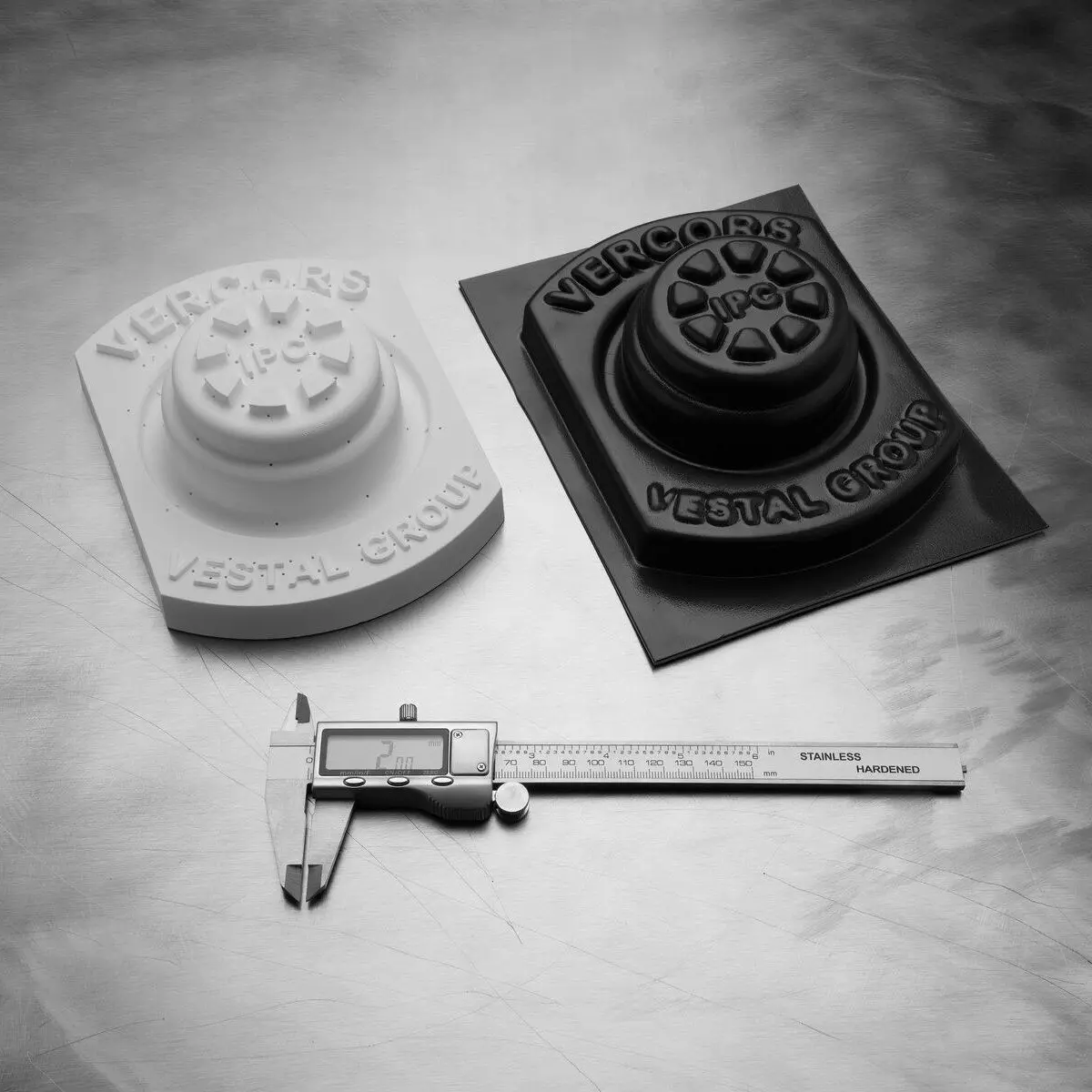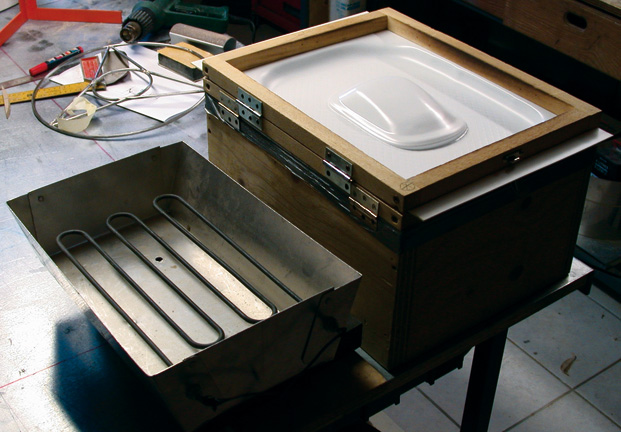The draw ratio in vacuum forming refers to the ratio between the initial sheet size and the final formed part dimensions.

Understanding Draw Ratio
Definition and Calculation
The draw ratio is a crucial concept in the realm of vacuum forming. Simply put, it describes the relationship between the initial size of the plastic sheet and the final size after the forming process. The draw ratio is typically calculated as:
Draw Ratio=Area of formed partOriginal sheet area
For instance, if you start with a plastic sheet that’s 100cm x 100cm (10,000 cm²) and end up with a product that’s 50cm x 50cm (2,500 cm²), your draw ratio would be 0.25.
Factors Affecting Draw Ratio
Several factors can influence the draw ratio in vacuum forming:
- Material Type: Different materials have varying stretchability. For instance, polystyrene might have a different optimal draw ratio compared to polyethylene.
- Temperature: The temperature at which the plastic is heated can alter its stretchability. A temperature of 150°C might make the plastic more malleable than at 100°C.
- Tooling Design: The design of the mold and the equipment can influence the draw ratio. A mold with complex features or sharp angles might require a different draw ratio than a simpler mold.
- Forming Speed: The speed at which the plastic is formed can affect its stretching. A forming speed of 500mm/s might stretch the material differently than a speed of 250mm/s.
Benefits of Optimal Draw Ratio
Achieving the right draw ratio is essential for several reasons:
- Quality: Maintaining an optimal draw ratio ensures uniform wall thickness and reduces the risk of defects. For a product with dimensions of 30cm x 20cm x 10cm, a consistent wall thickness of 2mm might be the target.
- Efficiency: The right draw ratio can maximize the efficiency of the material used, leading to less waste. If one sheet costs $5, and the optimal draw ratio reduces waste by 20%, that’s a saving of $1 per sheet.
- Performance: A product formed with the correct draw ratio will have the desired mechanical properties, ensuring it lasts for its intended lifespan. For a container meant to last 5 years, an incorrect draw ratio might reduce its lifespan to just 3 years.
- Costs: Reducing waste and ensuring product quality can lead to significant cost savings in the long run. If a manufacturing unit produces 1,000 pieces a day, even a small cost saving of $0.10 per piece due to the optimal draw ratio can lead to a daily saving of $100.
Impact of Draw Ratio on Product Quality
Distribution of Wall Thickness
One of the most direct impacts of draw ratio in vacuum forming is the distribution of wall thickness across the final product. The draw ratio determines how much the plastic sheet stretches, directly influencing the uniformity of thickness.
- Consistency: Achieving a consistent wall thickness ensures the product’s structural integrity. For instance, a product designed to have a 3mm thickness but varies between 2mm to 4mm can lead to weaknesses or excessive material use.
- Material Efficiency: Ensuring a consistent thickness means that the material is used efficiently. For a sheet costing $8, achieving consistent thickness can mean savings of up to $1.60 (20%) on material waste.
- Performance Parameters: Products with uniform wall thickness perform predictably. For a container designed to hold 25 liters of liquid, any inconsistency in thickness might reduce its volume capacity by 5 liters.
Effects on Mechanical Properties
The draw ratio also has a profound impact on the mechanical properties of the formed product:
- Strength: A higher draw ratio can sometimes thin out the material excessively, reducing its tensile strength. A product expected to withstand a pressure of 50N/cm² might see a drop to 30N/cm² with an incorrect draw ratio.
- Flexibility: Depending on the material, its flexibility can either increase or decrease with changes in draw ratio. A car dashboard panel with a flexibility parameter of 5 might change to 7 or 3 based on the draw ratio applied.
- Durability: A product’s lifespan can be significantly affected. If a component is expected to last 10 years, an unfavorable draw ratio might cut its life down to 6 years.
Aesthetics and Surface Finish
Aesthetics play a crucial role in consumer products, and the draw ratio can significantly influence the final appearance:
- Surface Smoothness: An optimal draw ratio ensures that the material stretches uniformly, leading to a smooth surface finish. A surface roughness parameter (Ra) of 2µm could deteriorate to 5µm with an incorrect draw ratio.
- Detail Reproduction: The right draw ratio ensures that every detail of the mold reflects on the product. For a product with an intricate design measuring 0.5mm in depth, an incorrect draw ratio might blur or erase such details, making them just 0.2mm deep.
- Visual Defects: Webbing, wrinkles, or bubbles can appear with a non-optimal draw ratio, reducing the product’s visual appeal and market value. A product priced at $60 could see a markdown to $40 due to these defects.

Challenges in Maintaining Optimal Draw Ratio
Uneven Material Stretch
In the vacuum forming process, achieving a uniform stretch across the entire plastic sheet remains one of the most significant challenges. Uneven material stretch can result in varying wall thicknesses across the product. For instance, one side of a product might have a thickness of 3mm, while another side might only be 1mm thick. This inconsistency can lead to several issues:
- Structural Weakness: Regions with less thickness can become weak points, making the product more susceptible to breakage or damage. For a product expected to carry a load of 20kg, an uneven stretch can reduce its capacity by as much as 50%, only allowing it to safely hold 10kg.
- Aesthetic Issues: Uneven stretching can lead to visible flaws on the product’s surface, reducing its visual appeal. This can be detrimental, especially for products where aesthetics play a crucial role, potentially reducing its market value from $50 to as low as $30.
- Increased Material Costs: Using more material to compensate for uneven stretches can escalate costs. For a manufacturing process using sheets costing $10 each, a 10% increase in material usage due to uneven stretch can result in additional costs of $1 per sheet.
Risk of Webbing or Bridging
Another common challenge in vacuum forming is the risk of webbing or bridging. Webbing occurs when the plastic sheet forms unwanted thin strands between two points on the mold. This can be due to a variety of factors:
- High Draw Ratios: Drawing the material too much can increase the risk of webbing. If a draw ratio of 0.5 is optimal, pushing it to 0.7 might increase the webbing risk significantly.
- Complex Mold Designs: Molds with intricate details or deep recesses can trap air, leading to webbing. For instance, a mold with a depth of 10cm might have a higher webbing risk than one with a depth of 5cm.
- Rapid Forming Speeds: Forming the material too quickly can prevent it from adapting smoothly to the mold’s shape. A speed of 800mm/s might lead to more webbing than a more controlled speed of 400mm/s.
Techniques to Optimize Draw Ratio
Pre-stretching or Pre-heating
Optimizing the draw ratio often begins even before the actual vacuum forming process starts. One of the primary methods to achieve this is through pre-stretching or pre-heating:
- Uniformity: Pre-stretching the plastic sheet ensures a more even distribution when it’s formed over the mold. By stretching a 100cm x 100cm sheet to 105cm x 105cm, you can achieve a smoother form over intricate molds.
- Temperature Control: Pre-heating the plastic sheet to a specific temperature, say 120°C instead of the standard 100°C, can enhance its pliability. This ensures that when the vacuum forms the plastic, it adapts better to the mold’s shape.
- Cost Savings: With optimized pre-stretching or pre-heating, less material waste occurs. For sheets costing $7 each, a 15% reduction in waste due to pre-treatment can result in a saving of $1.05 per sheet.
- Time Efficiency: A well-pre-stretched or pre-heated sheet might reduce the forming time by 10%. For a process that usually takes 5 minutes, this technique can save 30 seconds per cycle, enhancing production speed.
Tool and Mold Design Considerations
The tools and molds used in vacuum forming play a pivotal role in determining the draw ratio. Proper tool and mold design can lead to optimal results:
- Smooth Transitions: Molds designed with smoother transitions and curves reduce the risk of excessive stretching in specific areas. For a mold with a depth of 20cm, a smooth curve can ensure even thickness distribution, maintaining an average thickness of 2.5mm.
- Draft Angles: Incorporating draft angles in the mold design facilitates easier removal of the formed product without causing deformation. A draft angle of 5° might be optimal for a product measuring 50cm x 30cm.
- Material Selection for Molds: The choice of material for the mold can influence heat distribution and, consequently, the draw ratio. A steel mold might distribute heat more uniformly than an aluminum one, ensuring a consistent temperature of 110°C across the surface.
- Optimal Costing: Investing in well-designed molds might have an initial higher cost, say $5000 instead of $4000, but the long-term savings in terms of reduced material waste, better product quality, and faster production cycles can outweigh the initial investment.

Case Studies: Impact of Draw Ratio on Common Products
Packaging Industry
Scenario: A leading packaging company was producing food containers using vacuum forming. They noticed variations in the lid fit due to inconsistent wall thickness.
Intervention: After analyzing, they identified that the draw ratio was not optimal. They adjusted the draw ratio by altering the pre-heating temperature and modifying the mold’s design.
Outcome:
- The containers now had a consistent wall thickness of 2mm, ensuring that the lids fit perfectly every time.
- This adjustment led to a 10% reduction in material wastage, saving the company approximately $20,000 annually, given their production scale.
- Customer complaints reduced by 70%, leading to increased brand trust and repeat orders.
Insight: In the packaging industry, even minor inconsistencies can have significant repercussions. The optimal draw ratio ensures product uniformity and reduces material waste.
Automotive Components
Scenario: A car manufacturing company was sourcing vacuum-formed dashboard panels. Some of the panels developed warps or were not fitting seamlessly into the car interiors.
Intervention: The manufacturer adjusted the draw ratio by pre-stretching the plastic sheets and optimizing the forming speed. They also redesigned the mold to accommodate the draw ratio changes.
Outcome:
- The panels produced post-intervention had no warping and fitted perfectly, reducing assembly time by 15%.
- The mechanical properties of the panels improved, with a 20% increase in tensile strength.
- The cost per car reduced by $50 due to reduced wastage and faster assembly times.
Insight: Automotive components require precision and durability. Optimizing the draw ratio can lead to components that are both functionally superior and cost-effective.
Consumer Electronics
Scenario: A company producing vacuum-formed casings for a popular tablet model noticed variations in product aesthetics, with some units showing minor surface blemishes.
Intervention: They identified the draw ratio as the culprit. Changes were made in the mold design, especially in areas with intricate details, and the pre-heating process was fine-tuned.
Outcome:
- The new batches had a smooth finish, and the blemishes were eliminated.
- The tablet’s market reviews improved, with a 25% increase in positive feedback related to build quality.
- Return rates due to cosmetic defects dropped by 90%, saving the company approximately $200,000 in potential losses.
Insight: In consumer electronics, aesthetics play a huge role in consumer perception. Achieving the right draw ratio ensures that products not only function well but also look premium.




